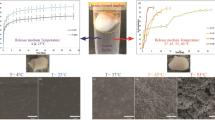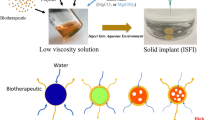Abstract
A patient-friendly delivery system to release human growth hormone (hGH) is very desirable. In situ forming implant systems (ISIs) can provide a long acting and effective protein delivery. In these systems, solvents and additives play major roles in drug release. In this study, four groups of PLGA-based ISIs containing hGH were prepared in N-methyl-2-pyrrolidone (NMP) and poly(ethylene glycol) dimethyl ether (PEG-DME) as solvents with and without tris(hydroxymethyl) aminomethane (Tris) as stabilizer. Several analyses were used to investigate the implants, which include release profile, viscosity, contact angle, gel permeation chromatography (GPC), scanning electron microscopy (SEM), hGH and IGF-1 serum measurements and histopathology. In in vitro release experiments, the hGH cumulative release from PEG-DME system was twice that from NMP system during 14 days, and hGH release was tripled in the presence of Tris. With the addition of Tris to the ISIs containing PEG-DME, the water penetration, interconnectivity of pores and inner channels, surface pores and hydrophilicity were increased. Moreover, the effect of Tris on the hGH stabilization synergized its positive effects and increased the hGH final cumulative release. Results of the ISIs containing PEG-DME and Tris injection in rabbits demonstrated a reduced tissue inflammation. Moreover, the 14-days serum levels of the hGH and IGF-1 of this system in recipient rabbits were comparable to those of the commercial daily injection samples.






Similar content being viewed by others
References
Cázares-Delgadillo J, Ganem-Rondero A, Kalia YN (2011) Human growth hormone: New delivery systems, alternative routes of administration, and their pharmacological relevance. Eur J Pharm Biopharm 78:278–288
Yoo HS (2007) Photo-cross-linkable and thermo-responsive hydrogels containing chitosan and Pluronic for sustained release of human growth hormone (hGH). J Biomater Sci Polym Ed 18:1429–1441
Jostel A, Mukherjee A, Alenfall J, Smethurst L, Shalet SM (2005) A new sustained-release preparation of human growth hormone and its pharmacokinetic, pharmacodynamic and safety profile. Clin Endocrinol (Oxf) 62:623–627
Parent M, Nouvel C, Koerber M, Sapin A, Maincent P, Boudier A (2013) PLGA in situ implants formed by phase inversion: critical physicochemical parameters to modulate drug release. J Control Release 172:292–304
Vaishya R, Khurana V, Patel S, Mitra AK (2015) Long-term delivery of protein therapeutics. Expert Opin Drug Deliv 12:415–440
Thakur RRS, McMillan HL, Jones DS (2014) Solvent induced phase inversion-based in situ forming controlled release drug delivery implants. J Control Release 176:8–23
Prabhu N, Sharp K (2006) Protein-solvent interactions. Chem Rev 106:1616–1623
Swed A, Cordonnier T, Fleury F, Boury F (2014) Protein encapsulation into PLGA nanoparticles by a novel phase separation method using non-toxic solvents. J Nanomed Nanotechnol 5:1000241
Schoenhammer K, Petersen H, Guethlein F, Goepferich A (2009) Injectable in situ forming depot systems: PEG-DAE as novel solvent for improved PLGA storage stability. Int J Pharm 371:33–39
Dong WY, Körber M, López Esguerra V, Bodmeier R (2006) Stability of poly(d, l-lactide-co-glycolide) and leuprolide acetate in in-situ forming drug delivery systems. J Control Release 115:158–167
Voigt M (2011) Biodegradable non-aqueous in situ forming microparticle drug delivery systems. PhD thesis, Freien Universität Berline
Schoenhammer K, Petersen H, Guethlein F, Goepferich A (2009) Poly(ethyleneglycol) 500 dimethylether as novel solvent for injectable in situ forming depots. Pharm Res 26:2568–2577
Zhu G, Mallery SR, Schwendeman SP (2000) Stabilization of proteins encapsulated in itjectable poly(lactide -co-glycolide). Nat Biotechnol 18:52–57
Takada S, Yamagata Y, Misaki M, Taira K, Kurokawa T (2003) Sustained release of human growth hormone from microcapsules prepared by a solvent evaporation technique. J Control Release 88:229–242
Mohammadpanah H, Rastegar H, Ramazani MR, Jaafari MR (2013) Effects of different buffers and pH on the stability of recombinant human growth hormone. Biosci Biotechnol Res Asia 10:193–203
Taha M, Lee M-J (2010) Interactions of TRIS [tris(hydroxymethyl)aminomethane] and related buffers with peptide backbone: Thermodynamic characterization. Phys Chem Chem Phys 12:12840–12850
Gourabi H, Mobedi H, Mirzaei S , Khezli S (2019) Dissolution test for sensitive drug. US patent 20190101518-A1.
Mirzaei S, Mobedi H, Gourabi H, Sanati MH, Khezli S, Omidian H, Ighaeie M (2021) Enhancement of the stability of human growth hormone by using tris(hydroxymethyl)aminomethane: molecular docking and experimental analysis. Cell J 22:406–414
Darestani-Farahani M, Vasheghani-Farahani E, Mobedi H, Ganji F (2016) The effect of solvent composition on vancomycin hydrochloride and free base vancomycin release from in situ forming implants. Polym Adv Technol 27:1653–1663
Conesa A, Shen S, Coronas A (1998) Liquid densities, kinematic viscosities, and heat capacities of some ethylene glycol dimethyl ethers at temperatures from 283.15 to 423.15 K. Int J Thermophys 19:1343–1358
Schenderlein S, Lück M, Müller BW (2004) Partial solubility parameters of poly(D, L-lactide-co-glycolide). Int J Pharm 286:19–26
Graham PD, Brodbeck KJ, McHugh AJ (1999) Phase inversion dynamics of PLGA solutions related to drug delivery. J Control Release 58:233–245
Zhu G, Mallery SR, Schwendeman SP (2000) Stabilization of proteins encapsulated in injectable-UK-2000. Nat Biotechnol 18(1):52–57
Wei Y, Wang Y, Kang A, Wang W, Ho SV, Gao J, Ma G, Su Z (2012) A novel sustained-release formulation of recombinant human growth hormone and its pharmacokinetic, pharmacodynamic and safety profiles. Mol Pharm 9:2039–2048
Körber M, Bodmeier R (2008) Development of an in situ forming PLGA drug delivery system. I. Characterization of a non-aqueous protein precipitation. Eur J Pharm Sci 35:283–292
Fredenberg S, Wahlgren M, Reslow M, Axelsson A (2011) The mechanisms of drug release in poly(lactic-co-glycolic acid)-based drug delivery systems—a review. Int J Pharm 415:34–52
Bielohuby M, Zarkesh-Esfahani SH, Manolopoulou J, Wirthgen E, Walpurgis K, Khorasgani MT, Aghili ZS, Wilkinson IR, Hoeflich A, Thevis M, Ross RJ, Bidlingmaier M (2014) Validation of serum IGF-I as a biomarker to monitor the bioactivity of exogenous growth hormone agonists and antagonists in rabbits. Dis Model Mech 7:1263–1273
Kramer WG, Jaron-mendelson M, Koren R, Hershkovitz O, Hart G (2018) Pharmacokinetics, pharmacodynamics, and safety of a long-acting human growth hormone (MOD-4023) in healthy Japanese and Caucasian adults. Clin Pharmacol Drug Dev 7:554–563
Acknowledgements
This work was supported by Royan institute and Iran Polymer and Petrochemical institute that provided the funding.
Author information
Authors and Affiliations
Corresponding author
Electronic supplementary material
Below is the link to the electronic supplementary material.
Rights and permissions
About this article
Cite this article
Mirzaei, S., Mobedi, H., Gourabi, H. et al. Release of human growth hormone from an in-situ implant modulated by poly(ethylene glycol) dimethyl ether and tris(hydroxymethyl) aminomethane. Iran Polym J 29, 1019–1029 (2020). https://doi.org/10.1007/s13726-020-00857-x
Received:
Accepted:
Published:
Issue Date:
DOI: https://doi.org/10.1007/s13726-020-00857-x




